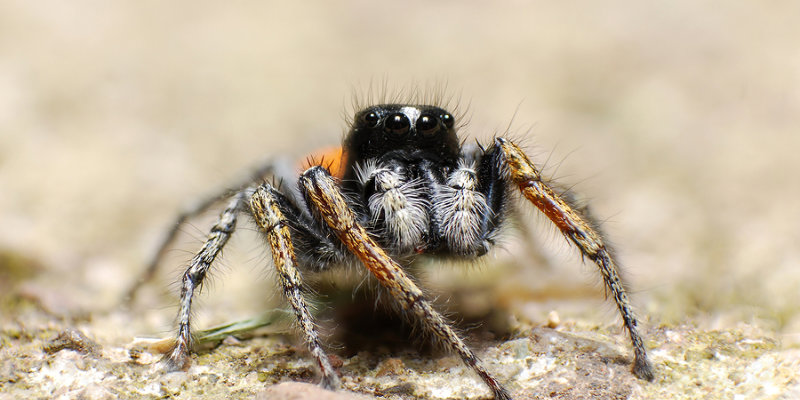Jumping spiders are generally recognized by their eye pattern. They typically have eight eyes arranged in two or three rows. The front, and most distinctive row is enlarged and forward facing to enable stereoscopic vision. The others are situated back on the cephalothorax.

- Colours and patterns vary widely. Several species of jumping spiders appear to mimic ants, beetles, or pseudoscorpions. Others may appear to be parts of grass stems, bumps on twigs, bark, part of a rock or even part of a sand surface.
- The jumping spider family (Salticidae) contains more than 500 described genera and over 5,000 species, making it the largest family of spiders with about 13% of all species (Peng et al., 2002). Jumping spiders have good vision and use it for hunting and navigating. They are capable of jumping from place to place, secured by a silk tether. Both their book lungs and the tracheal system are well-developed, as they depend on both systems (bimodal breathing).
- Jumping spiders are generally diurnal, active hunters. Their well developed internal hydraulic system extends their limbs by altering the pressure of body fluid (blood) within them. This enables the spiders to jump without having large muscular legs like a grasshopper. The jumping spider can therefore jump 20 to 60 or even 80 times the length of their body. When a jumping spider is moving from place to place, and especially just before it jumps, it tethers a filament of silk to whatever it is standing on. Should it fall for one reason or another, it climbs back up the silk tether.
- Unlike almost all other spiders, they can quite easily climb on glass. Minute hairs and claws on their feet enable them to grip imperfections in the glass.
- Jumping spiders also use their silk to weave small tent-like dwellings where females can protect their eggs, and which also serve as a shelter while moulting.
- Jumping spiders are known for their curiosity. If approached by a human hand, instead of scuttling away to safety as most spiders do, the jumping spider will usually leap and turn to face the hand. Further approach may result in the spider jumping backwards while still eyeing the hand. The tiny creature will even raise its forelimbs and “hold its ground.” Because of this contrast to other arachnids, the jumping spider is regarded as inquisitive as it is seemingly interested in whatever approaches it.
At Longhorn Termite & Pest Control, we get rid of jumping spiders for customers in Azle, Weatherford, Benbrook, and Graham, Texas.
